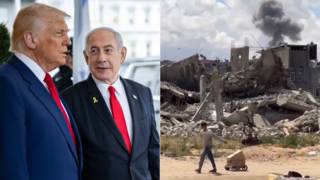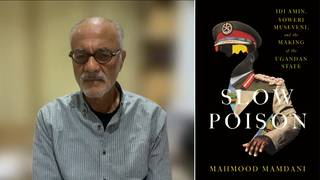
Guests
- Marylia Kelleyexecutive director of Tri-Valley CAREs, or Communities Against a Radioactive Environment.
We are on the road in New Mexico, home to Los Alamos and the birthplace of the nuclear age. The atomic bombs used in World War II were designed and developed here, and it remains one of two places that design every nuclear weapon in the United States arsenal. This comes as today marks the 30th anniversary of the Chernobyl nuclear plant disaster in the former Soviet state of Ukraine, which is still considered the worst nuclear disaster in history. It sent a cloud of radioactive fallout into Russia, Belarus and over a large portion of Europe. Fifty thousand people living in Chernobyl’s immediate surroundings had to be evacuated, and a vast rural region became uninhabitable. The legacy of Chernobyl and the Fukushima Daiichi nuclear power accident, which occurred five years ago last month in Japan, particularly resonates with residents here in the Southwest and in the Western United States. The other facility is in Livermore Lab in California, and we recently spoke with Marylia Kelley, a Livermore resident and the executive director of Tri-Valley CAREs, or Communities Against a Radioactive Environment, a partner organization with the Alliance for Nuclear Accountability. The group just put out a new report called “Trillion Dollar Trainwreck: Out-of-control U.S. nuclear weapons programs accelerate spending, proliferation, health and safety risks.”
Transcript
AMY GOODMAN: We’re on the road in Santa Fe, New Mexico. We end today marking the 30th anniversary of the Chernobyl nuclear plant disaster in the former Soviet state of Ukraine, still considered the worst nuclear disaster in history. It sent a cloud of radioactive fallout into Russia, Belarus and over a large portion of Europe. Fifty thousand people living in Chernobyl’s immediate surroundings had to be evacuated, and a vast rural region became uninhabitable, including the town of Pripyat, near where the damaged reactor was located. Residents had to be permanently relocated, and the town remains abandoned. Lyudmila Kamkina, a former employee at the Chernobyl plant, spoke at a memorial ceremony held earlier today in the Ukrainian capital of Kiev.
LYUDMILA KAMKINA: [translated] We did not think that this accident would change all our lives and our lives would be divided into “before the war” and “after the war,” as we call it. It was silent nuclear war for us, for those who lived there in Pripyat and who worked at the station.
AMY GOODMAN: The legacy of Chernobyl and the Fukushima Daiichi nuclear power accident, which occurred five years ago last month in Japan, particularly resonates with residents here in the Southwest and in the Western United States. Los Alamos, New Mexico, is the birthplace of the nuclear age. The atomic bombs used in World War II were designed and developed there, and it remains one of two places that design every nuclear weapon in the United States arsenal. The other, Livermore Lab in California.
Recently, I sat down with Marylia Kelley. We were at Stanford University when she came in from her home in Livermore. She’s the executive director of Tri-Valley CAREs, or Communities Against a Radioactive Environment, a partner group with the Alliance for Nuclear Accountability, the group that just put out a report called “Trillion Dollar Trainwreck: Out-of-control U.S. nuclear weapons programs accelerate spending, proliferation, health and safety risks.” I asked her to talk about contamination where she lives, at Livermore.
MARYLIA KELLEY: Livermore Lab is a Superfund cleanup site, meaning it’s on the EPA’s list of most contaminated locations in the country. I recently moved, but under my old home was an offsite groundwater plume emanating from the lab with toxic waste in it. There’s leaking—leaching down through the soil into the aquifer a number of toxic and radioactive materials that come from the nuclear weapons work. They found elevated levels of plutonium in Big Trees Park near where I lived. There have—there’s real danger. And there have been major, major accidents. Two of the three biggest accidents in the country with radioactive hydrogen, which is called tritium, happened at Livermore Lab, airborne releases of this radioactive hydrogen. Also, there have been airborne releases of uranium, of plutonium, etc.
AMY GOODMAN: Well, here you have a situation where the scientists live in this community, this endangered community.
MARYLIA KELLEY: Yes.
AMY GOODMAN: And perhaps there’s no one more than the scientists who understand the dangers of the environment they’re in. Are you finding allies within Livermore?
MARYLIA KELLEY: Tri-Valley CAREs was founded in 1983. And we—one of our founding handful of folks, one of our founding six, was a laboratory scientist. We now have 5,600 members, and so there are hundreds of lab scientists and engineers and technicians among our membership. Some go into denial. Others really want to do something to make the environment better. Some want to actually change the lab’s mission to a civilian science mission. For us, the issue isn’t should our country have scientists; the issue is what should they be paid to do. We’re very pro-science. We want to see the small, tiny part of the lab where they do actual civilian science grow and become the center of the lab.
AMY GOODMAN: You talk about leaving radioactive waste where it is. What are the communities of the United States that house nuclear waste? And what should be done about it?
MARYLIA KELLEY: Nuclear waste is a very, very difficult issue. So, step one is start—step one is stop producing it. Once you produce a nuclear waste, you have to sort of choose the best of the bad options. And there was a very politically driven program to dump a high level—this is the irradiated nuclear fuel rods—in Yucca Mountain in Nevada, which we opposed. Right now, the Department of Energy is going through what it calls a consent-based process to try to find communities that will “consent” to becoming either interim storage or disposal sites. But the Department of Energy—
AMY GOODMAN: And do they consent because they’re poor? What do they get for this?
MARYLIA KELLEY: Well, this is what we’re discussing: What does consent mean? Informed consent means they understand the risks. How do they—how does a community consent for future generations that are unborn? I’ll give you one example. Plutonium-239 has a—which is weapons-grade plutonium—has a half-life of 24,400 years. A hazardous life is roughly 10 half-lives, 240,000 years. How do you truly consent for 240,000 years? So, why—and is the agency that’s in charge of our nuclear weapons program the right agency to go out and talk about consent? DOE has shown that it doesn’t understand consent. DOE’s modus operandi, we call it DAD—decide, announce, defend. They don’t understand consent. An independent agency needs to be taking a look at this. And in the meantime, where it’s safe, the nuclear waste should stay in place. And we are recommending that it be put in hardened on-site storage, so that it is not vulnerable where it presently sits. And ultimately, something will need to be done. But if the Department of Energy prevails on a particular community to “consent” to having an interim storage site, I predict that the first hole in the ground they get will be where the waste stays for a very, very long time. And so, we just—we need a process that is much, much better. And we need to understand that communities are and will be sacrificing because we have produced these wastes. And for the future, we at least owe it to our children and our grandchildren and their children and grandchildren for the next couple hundred thousand years not to continue producing these wastes.
AMY GOODMAN: That was Marylia Kelley. She is with Communities Against a Radioactive Environment. She’s a resident of Livermore, California, where the National Lab Livermore is. We’re broadcasting from New Mexico, home of the three—two of the three national labs, at Los Alamos and Sandia. Today is the 30th anniversary of the nuclear disaster in Chernobyl.
We will be in Las Alamos today at noon, where I’ll be speaking, part of our 100-city tour. I want to say congratulations to Democracy Now!'s Isis Phillips on the birth of her daughter, Ooona Vida Guerra Phillips. We are on a 100-city tour marking Democracy Now!'s 20th anniversary. Yes, today at noon, I’ll be speaking in Las Alamos, tonight at the Lensic theater here in Santa Fe. On Wednesday, I’ll be in Flagstaff. On Thursday in Phoenix and Tucson, we’ll be speaking, and on Friday in Fresno. On Saturday, we’ll be in San Mateo and Grass Valley, California, then Houston and New Orleans on Sunday, May 1st. Democracy Now! will be—on Monday, we’ll be moving on to Atlanta [Tuesday] and Sarasota. Check our website, democracynow.org.














Media Options